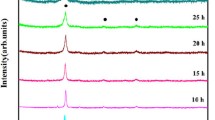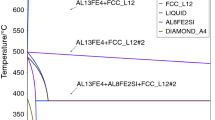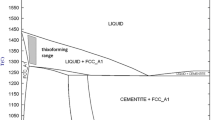Abstract
Phase change materials (PCMs) can store and release the latent heat associated with a phase transition, so they can be applied in thermal energy management and storage systems. Among them, form-stable (FS) PCMs can consist of two immiscible phases: an active phase, which undergoes the solid–liquid transition, and a matrix, which provides the structural properties and prevents leakage of the active phase when it is liquid. This experimental study focused on the characterization of a metallic FS-PCMs based on an Al–Sn alloy, obtained by powder metallurgy from ball-milled powders, compacted at room temperature and sintered at 200, 250 and 500 °C. The main properties that characterize PCMs are the temperature range over which transition occurs and the associated enthalpy, i.e. the stored energy. Differential scanning calorimetry (DSC) is one of the more suitable characterization techniques to evaluate these properties and so the thermal response of PCMs. To check thermal response and its stability, DSC tests including several thermal cycles were conducted. DSC analyses were performed also before and after several thermal cycles simulating possible operative conditions. Moreover, microstructural analysis, through scanning electron microscopy and X-ray diffraction, allowed to relate the thermal response variations to microstructural and mechanical changes.
















Similar content being viewed by others

References
Pielichowska K, Pielichowski K. Phase change materials for thermal energy storage. Prog Mater Sci. 2014;65:67–123. https://doi.org/10.1016/J.PMATSCI.2014.03.005.
Kenisarin MM. High-temperature phase change materials for thermal energy storage. Renew Sustain Energy Rev. 2010;14:955–70. https://doi.org/10.1016/J.RSER.2009.11.011.
Kuta M, Matuszewska D, Wójcik TM. The role of phase change materials for the sustainable energy. E3S Web Conf. 2016;10:68. https://doi.org/10.1051/e3sconf/20161000068.
Kuta M, Wójcik TM. Phase change materials in energy sector—applications and material requirements. EPJ Web Conf. 2015;92:2043. https://doi.org/10.1051/epjconf/20159202043.
Sugo H, Kisi E, Cuskelly D. Miscibility gap alloys with inverse microstructures and high thermal conductivity for high energy density thermal storage applications. Appl Therm Eng. 2013;51:1345–50. https://doi.org/10.1016/J.APPLTHERMALENG.2012.11.029.
Zhou C, Wu S. Medium- and high-temperature latent heat thermal energy storage: material database, system review, and corrosivity assessment. Int J Energy Res. 2019;43:621–61. https://doi.org/10.1002/er.4216.
Wei G, Wang G, Xu C, Ju X, Xing L, Du X, Yang Y. Selection principles and thermophysical properties of high temperature phase change materials for thermal energy storage: a review. Renew Sustain Energy Rev. 2018;81:1771–86. https://doi.org/10.1016/J.RSER.2017.05.271.
Mohamed SA, Al-Sulaiman FA, Ibrahim NI, Zahir MH, Al-Ahmed A, Saidur R, Yılbaş BS, Sahin AZ. A review on current status and challenges of inorganic phase change materials for thermal energy storage systems. Renew Sustain Energy Rev. 2017;70:1072–89. https://doi.org/10.1016/J.RSER.2016.12.012.
Singh SP, Deb-Barman BK, Kumar P. Cu–Bi alloys with high volume fraction of Bi: a material potentially suitable for thermal surge protection and energy storage. Mater Sci Eng A. 2016;677:140–52. https://doi.org/10.1016/j.msea.2016.09.041.
Reed S, Sugo H, Kisi E. High temperature thermal storage materials with high energy density and conductivity. Sol Energy. 2018;163:307–14. https://doi.org/10.1016/J.SOLENER.2018.02.005.
Fiedler T, Rawson AJ, Sugo H, Kisi E. Thermal capacitors made from miscibility gap alloys (MGAs). WIT Trans Ecol Environ. 2014. https://doi.org/10.2495/esus140411.
Liu X, Zeng MQ, Ma Y, Zhu M. Promoting the high load-carrying capability of Al–20 wt% Sn bearing alloys through creating nanocomposite structure by mechanical alloying. Wear. 2012;294–295:387–94. https://doi.org/10.1016/j.wear.2012.07.021.
Gariboldi E, Perrin M. Metallic composites as form-stable phase change alloys. THERMEC 2018 Trans Tech Publ. 2019. https://doi.org/10.4028/www.scientific.net/MSF.941.1966.
Suryanarayana C. Mechanical alloying and milling. Prog Mater Sci. 2001;46:1–184. https://doi.org/10.1016/S0079-6425(99)00010-9.
Confalonieri C, Li Z, Gariboldi E. Metallic form-stable phase change materials for thermal energy storage and management: general features and effect of manufacturing process on thermal response and stability. La Metall Ital Int J Ital Assoc Metall. 2019;7(8):12–20.
Toda A. Heating rate dependence of melting peak temperature examined by DSC of heat flux type. J Therm Anal Calorim. 2016;123:1795–808. https://doi.org/10.1007/s10973-015-4603-3.
Liu X, Zeng MQ, Ma Y, Zhu M. Melting behavior and the correlation of Sn distribution on hardness in a nanostructured Al–Sn alloy. Mater Sci Eng A. 2009;506:1–7. https://doi.org/10.1016/J.MSEA.2008.12.054.
Exner HE, Arzt E. Sintering processes. In: Cahn RW, Haasen P, editors. Physics of metals. 4th ed. Oxford: North-Holland; 1996. p. 2627–62. https://doi.org/10.1016/B978-044489875-3/50036-3.
Gražulis S, Daškevič A, Merkys A, Chateigner D, Lutterotti L, Quirós M, Serebryanaya NR, Moeck P, Downs RT, Le Bail A. Crystallography open database (COD): an open-access collection of crystal structures and platform for world-wide collaboration. Nucleic Acids Res. 2012;40:D420–7. https://doi.org/10.1093/nar/gkr900.
Wyckoff RWG. Crystal structure, vol. 1. 2nd ed. New York: Interscience Publishers; 1963. p. 7–237.
Lutterotti L, Maud, (n.d.). http://maud.radiographema.eu.
Hemminger WF, Sarge SM. The baseline construction and its influence on the measurement of heat with differential scanning calorimeters. J Therm Anal. 1991;37:1455–77. https://doi.org/10.1007/BF01913481.
Vanden-Poel G, Mathot VBF. High-speed/high performance differential scanning calorimetry (HPer DSC): temperature calibration in the heating and cooling mode and minimization of thermal lag. Thermochim Acta. 2006;446:41–54. https://doi.org/10.1016/j.tca.2006.02.022.
Steurer W. Crystal structures of the elements. Encycl Mater Sci Technol. 2001. https://doi.org/10.1016/b0-08-043152-6/00344-2.
Yu C, Liu J, Lu H, Chen J. Ab initio calculation of the properties and pressure induced transition of Sn. Solid State Commun. 2006;140:538–43. https://doi.org/10.1016/j.ssc.2006.09.026.
Gorokh AV, Danilenko IA, Primisler VB. Suppression of anomalous allotropic transformations at high pressures. Inorg Mater. 2003;39:183–5. https://doi.org/10.1023/A:1022154931469.
Navarrete N, Gimeno-Furio A, Mondragon R, Hernandez L, Cabedo L, Cordoncillo E, Julia JE. Nanofluid based on self-nanoencapsulated metal/metal alloys phase change materials with tuneable crystallisation temperature. Sci Rep. 2017;7:17580. https://doi.org/10.1038/s41598-017-17841-w.
Shackelford W, Alexander JF, editors. CRC materials science and engineering handbook. 3rd ed. Boca Raton: CRC Press; 2001. https://doi.org/10.1201/9781420038408.
Kim WT, Cantor B. Solidification of tin droplets embedded in an aluminium matrix. J Mater Sci. 1991;26:2868–78. https://doi.org/10.1007/BF01124815.
Acknowledgements
The authors would like to thank Aldo Tommaso Grimaldi, for samples production and initial characterization, and Enrico Bassani, for his help in XRD tests. This work was supported by the Italian Ministry for Education, University and Research through the Project Department of Excellence LIS4.0 (Integrated Laboratory for Lightweight e Smart Structures).
Author information
Authors and Affiliations
Corresponding author
Ethics declarations
Conflict of interest
The authors declare that they have no conflict of interest.
Additional information
Publisher's Note
Springer Nature remains neutral with regard to jurisdictional claims in published maps and institutional affiliations.
Rights and permissions
About this article
Cite this article
Confalonieri, C., Bassani, P. & Gariboldi, E. Microstructural and thermal response evolution of metallic form-stable phase change materials produced from ball-milled powders. J Therm Anal Calorim 142, 85–96 (2020). https://doi.org/10.1007/s10973-020-09785-7
Received:
Accepted:
Published:
Issue Date:
DOI: https://doi.org/10.1007/s10973-020-09785-7



